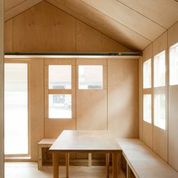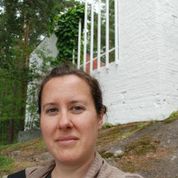In a landscape of trees, the fields appear like islands, providing intermittent view corridors while riding the train from Helsinki to Turku. The trees are prevalent, dominating the Finnish countryside both in nature and in the built environment. Birch, pine and spruce trees are harvested and employed in a variety of ways. Timber is part of Finnish identity, from the forests that thrive in the Nordic climate, to the tradition of building a summer cottage within the landscape.
My Fulbright U.S. Student Program grant took me to Helsinki, Finland to study the use of wood in Finnish Architecture. As a material to use in the construction of buildings, timber is unique. Timber breathes, it feels warm to the touch, it shrinks and expands and preserves the organic qualities that give it a connection to life. In the words of Juhani Pallasmaa, Finnish Architect and scholar: “Wood speaks of its two existences and time scales; its first life as a growing tree and the second as a human artifact made by the caring hand of a carpenter or cabinetmaker.”
My grant proposal incorporated classes in Helsinki at Aalto University, with travel research to see wooden architecture within the Finnish landscape; complimenting academic learning with the experience of being within a space. In person, the textures, light, and tactile elements of a design can be felt in a way not found in photographs.
Upon my arrival in Helsinki in August 2010, I enrolled in the Wood Program at Aalto University. The Wood Program coursework explores the ecological, technical, and architectural properties of wood. This thorough review of the whole chain of wood construction begins with the tree in the forest, and ends with an experimental wooden building. My Wood Program cohort, despite being immersed in architecture, found time to pause and appreciate the Finnish ritual of kahvipaussi, (fika in Swedish, coffee break in English). Finnish coffee should always be accompanied by pulla (a sweet roll with cardamom) or korvapuusti (cinnamon roll). One way for me to explore Finnish culture outside of architecture was through cooking. By the end of my Fulbright, the recipes for both pulla and korvapuusti were engrained in my memory, and they are now something I can continue to make for a lifetime.

Interior of Liina, a transitional refugee shelter built during Rebecca Littman-Smith’s grant in Finland
Architecture is a visual discipline; we sketch out ideas on napkins, scraps of sandpaper, or any surface which can contain our ideas. Regardless of our language or culture, I found the napkin sketch to be a collaborative tool invaluable for my Fulbright project. With my colleagues, we designed and built a small transitional shelter, a wooden building designed as temporary housing for refugees. The final building ‘Liina,’ illustrates a year of hands-on hard work, the evolution of ideas and understanding of wood and its use in Finnish Architecture.
Tips for Prospective Fulbright Applicants:
Bring with you passion, inquisitiveness, and flexibility.
Have questions, explore, and accept new ideas during your Fulbright journey.
Be fearless in pronouncing foreign words. Hand gestures are a great backup for communicating if people don’t understand.
Look up local holidays since they affect store hours, public transportation schedules, and provide great opportunities for immersion in new cultural experiences.
Once you have received a grant, reread your research Statement of Grant Purpose. By the time you arrive in country, months will have passed and your knowledge may have changed. Contacts could be working at other universities and you might come up with new opportunities that fit your project scope.



1 Comment
Good job Becky keep it up